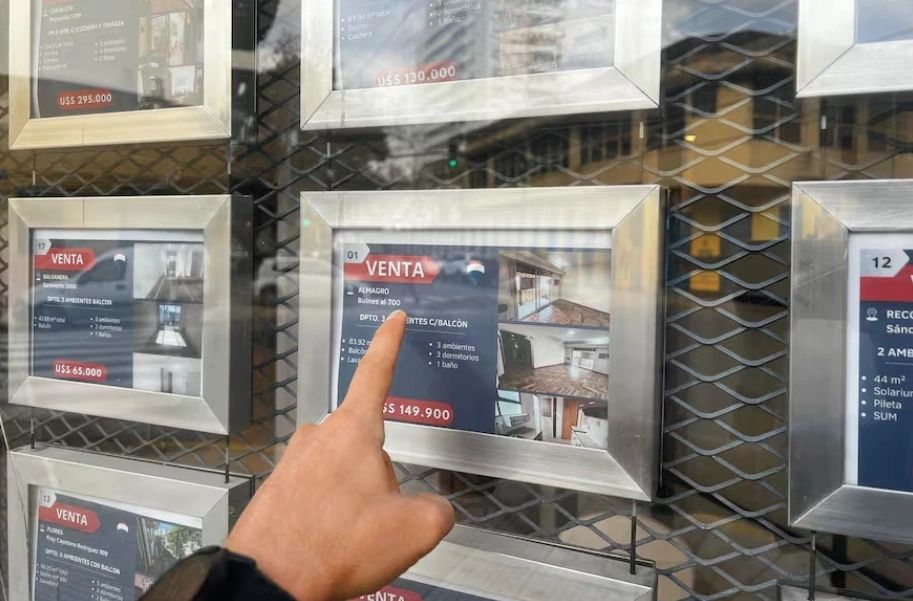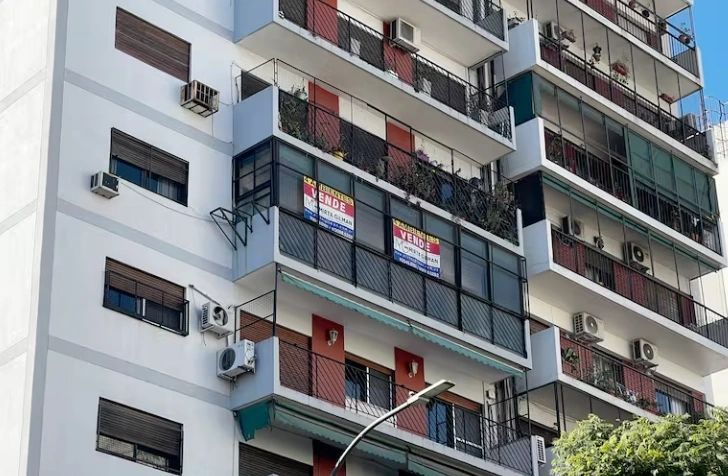BuySellBA
Administrator
Mortgage loans: With rising rates, is it better to pay a mortgage payment or rent? - La Nacion Propiedades

May 26, 2025
In recent months, 12 banks have raised their loan rates. How does this affect the payment? Will it offset rental costs?
By Candela Contreras

The decision between buying and renting will depend on several factors, but one of the most important is the comparison of the monthly payment.Daniel Basualdo
Since the end of 2024, the mortgage market in Argentina has experienced a scenario of constant rate adjustments .
Between November and December of that year, the costs of UVA mortgage loans began to skyrocket , and by May 2025, several entities had already implemented their third or fourth increase .
The result is an increasingly complex equation: is it more profitable to move into your own home or continue paying rent in the City of Buenos Aires?
What is the impact of these increases? Loans are becoming more expensive , and the number of people who can afford to own their own homes is shrinking.
In the case of UVA loans , whose rates are adjusted for inflation according to the CER index , the rate hike is particularly noticeable. While the indexation system makes these loans a viable option in inflationary contexts, interest rate increases can increasingly restrict access to loans .
The higher the rate, the higher the income the applicant must justify , since, due to bank conditions, the initial payment cannot exceed 25% (and in some cases up to 30%) of the family income.
So, as the rate increases , the amount of the down payment also increases , so a higher demonstrable income will be required. This is what can prevent a person from accessing a particular property. In this case, the best option would be to look for something smaller or in a more affordable neighborhood.
Rates currently average 4.9% for public or provincial banks , while private banks have already climbed to 7.8%, up from 5.5% initially, according to the consulting firm Empiria. This means an increase in the down payment (and required income) of more than 20% on a 20-year loan.
" The rate hike is partly offset by the 'fall' of the dollar —comparing today's official rate with the MEP rate before the end of the currency controls—so that may benefit demand. But banks remain strapped for liquidity," explains Federico González Rouco, an economist specializing in housing.

Average bank rates are at 4.9% for public or provincial entities, and private banks have already climbed to 7.8%.Inna Kot - Shutterstock
In March, 992 deeds with mortgages were registered in the City of Buenos Aires , approximately 20% of the total number of deeds for the month (4,747) and 1,042% more than the same month last year, according to the Buenos Aires Notaries Association. As for April, while we await the association's data, it is observed that US$278 million in UVA loans were granted in the fourth month of the year , according to data provided by the consulting firm Empiria based on the Central Bank.
“This volume of between two and three thousand loans per month is a sustainable volume,” adds González Rouco. “Let's not forget that all the strong loan growth stopped in September/October 2024, after which it slowed, and since then we've been relatively flat,” he maintains.
The rate hike is partly offset by the "fall" of the dollar , comparing today's official rate with the MEP rate before the currency controls were lifted, so that may benefit demand . But banks remain in a tight spot in terms of liquidity. "Banks may have a hard time continuing to grow, but it doesn't seem like they'll be able to stabilize at these levels."
For its part, Banco Nación currently accounts for the majority of mortgage lending , followed by Banco Galicia —on the private side— with more than 5,000 loans already granted , in a context in which many private banks “have no interest in lending, but end up filtering out demand with higher rates,” says González Rouco.
The economist interprets the phenomenon as a natural response to the imbalance between supply and demand : "There is a huge demand that grew very quickly, and at the same time, funding mortgage loans is expensive for banks because they involve loans with very high ticket prices," he notes. "The structural solution should involve tools such as portfolio titling or securitization , but in Argentina, these don't exist: it requires a level of financial sophistication that is far from the present."
The question now is whether rising rates will continue to affect the mortgage market in the coming months or whether banks will opt to maintain more affordable conditions to sustain the recovery . In an inflationary context, where UVAs represent the only viable option, the evolution of rates will be key to determining the future of the sector .
However, it should be noted that the average agreed-upon rate (for loans granted) in April was 5.8% , which reveals strong participation by institutions like Banco Nación, which continues to offer more affordable terms than other institutions.
In this context, mortgage loan rates range from 3% to 14% . Loan amounts can reach up to $250 million , although in some cases there is no maximum. These loans generally finance between 75% and 80% of the property's value, financing terms vary between 5 and 30 years, and installments , as UVA loans, are adjusted for inflation . Furthermore, the borrower's committed installment must represent between 20% and 30% of monthly income .

With the new rate hike by banks, the equation changesDaniel Basualdo
In response to this question, when LA NACION published this same article months ago, the calculations for both transactions were quite similar. Now, with the new rate hike, this equation changes :
The choice between buying and renting depends not only on the initial installment amount, but also on other factors such as job stability, the down payment required (20% to 35%, depending on the bank), and the long-term outlook (15 to 30 years) for the desired home. What weighs more heavily when making the decision, and what do you compromise on?
To illustrate the intersection between both alternatives, the example of a couple looking for a 50 m² one-bedroom apartment in Chacarita, valued at US$120,000 (about $144 million, assuming an official dollar of $1,200), takes a UVA bank loan for $108,000,000 and has initial savings of US$30,000 (25% of the property value):
Now, taking the average rate agreed in April, which was 5.8% , the account is as follows:
In contrast, the average rent for a similar unit in Chacarita is around $672,816 per month , less than three of the four cases presented. However, this time, the adjustment will also be for inflation, but every three or four months depending on the contract signed.
Another example, using the same asking price, can be seen in the purchase of a two-bedroom apartment in, for example, Paternal. In this area, the rental price with similar characteristics is around $605,575 , lower than in all other cases.
Ultimately, the decision to buy or rent will depend not only on a specific financial calculation, but also on each family's profile and the risks they are willing to take . As rates continue to rise, access to homeownership will remain higher than monthly rent payments, which could delay the dream of owning a home for an increasing portion of the population.
www.buysellba.com

May 26, 2025
In recent months, 12 banks have raised their loan rates. How does this affect the payment? Will it offset rental costs?
By Candela Contreras

The decision between buying and renting will depend on several factors, but one of the most important is the comparison of the monthly payment.Daniel Basualdo
Since the end of 2024, the mortgage market in Argentina has experienced a scenario of constant rate adjustments .
Between November and December of that year, the costs of UVA mortgage loans began to skyrocket , and by May 2025, several entities had already implemented their third or fourth increase .
The result is an increasingly complex equation: is it more profitable to move into your own home or continue paying rent in the City of Buenos Aires?
What is the impact of these increases? Loans are becoming more expensive , and the number of people who can afford to own their own homes is shrinking.
In the case of UVA loans , whose rates are adjusted for inflation according to the CER index , the rate hike is particularly noticeable. While the indexation system makes these loans a viable option in inflationary contexts, interest rate increases can increasingly restrict access to loans .
The higher the rate, the higher the income the applicant must justify , since, due to bank conditions, the initial payment cannot exceed 25% (and in some cases up to 30%) of the family income.
So, as the rate increases , the amount of the down payment also increases , so a higher demonstrable income will be required. This is what can prevent a person from accessing a particular property. In this case, the best option would be to look for something smaller or in a more affordable neighborhood.
Rates currently average 4.9% for public or provincial banks , while private banks have already climbed to 7.8%, up from 5.5% initially, according to the consulting firm Empiria. This means an increase in the down payment (and required income) of more than 20% on a 20-year loan.
" The rate hike is partly offset by the 'fall' of the dollar —comparing today's official rate with the MEP rate before the end of the currency controls—so that may benefit demand. But banks remain strapped for liquidity," explains Federico González Rouco, an economist specializing in housing.

Average bank rates are at 4.9% for public or provincial entities, and private banks have already climbed to 7.8%.Inna Kot - Shutterstock
In March, 992 deeds with mortgages were registered in the City of Buenos Aires , approximately 20% of the total number of deeds for the month (4,747) and 1,042% more than the same month last year, according to the Buenos Aires Notaries Association. As for April, while we await the association's data, it is observed that US$278 million in UVA loans were granted in the fourth month of the year , according to data provided by the consulting firm Empiria based on the Central Bank.
“This volume of between two and three thousand loans per month is a sustainable volume,” adds González Rouco. “Let's not forget that all the strong loan growth stopped in September/October 2024, after which it slowed, and since then we've been relatively flat,” he maintains.
The rate hike is partly offset by the "fall" of the dollar , comparing today's official rate with the MEP rate before the currency controls were lifted, so that may benefit demand . But banks remain in a tight spot in terms of liquidity. "Banks may have a hard time continuing to grow, but it doesn't seem like they'll be able to stabilize at these levels."
For its part, Banco Nación currently accounts for the majority of mortgage lending , followed by Banco Galicia —on the private side— with more than 5,000 loans already granted , in a context in which many private banks “have no interest in lending, but end up filtering out demand with higher rates,” says González Rouco.
The economist interprets the phenomenon as a natural response to the imbalance between supply and demand : "There is a huge demand that grew very quickly, and at the same time, funding mortgage loans is expensive for banks because they involve loans with very high ticket prices," he notes. "The structural solution should involve tools such as portfolio titling or securitization , but in Argentina, these don't exist: it requires a level of financial sophistication that is far from the present."
The question now is whether rising rates will continue to affect the mortgage market in the coming months or whether banks will opt to maintain more affordable conditions to sustain the recovery . In an inflationary context, where UVAs represent the only viable option, the evolution of rates will be key to determining the future of the sector .
However, it should be noted that the average agreed-upon rate (for loans granted) in April was 5.8% , which reveals strong participation by institutions like Banco Nación, which continues to offer more affordable terms than other institutions.
In this context, mortgage loan rates range from 3% to 14% . Loan amounts can reach up to $250 million , although in some cases there is no maximum. These loans generally finance between 75% and 80% of the property's value, financing terms vary between 5 and 30 years, and installments , as UVA loans, are adjusted for inflation . Furthermore, the borrower's committed installment must represent between 20% and 30% of monthly income .

With the new rate hike by banks, the equation changesDaniel Basualdo
The loan installment vs. the rent of an apartment in Buenos Aires
“Those who took out a UVA loan in the first phase—during the Macri administration—had initial payments that increased from 25% of the borrower's income to as much as 40% due to high inflation,” explained José Rozados, director of Reporte Inmobiliario. However, he also reflected: “ That percentage is very similar to what a person must allocate from their salary to pay rent .” Therefore, many people face a crucial decision: should they pay their mortgage installments or continue renting?In response to this question, when LA NACION published this same article months ago, the calculations for both transactions were quite similar. Now, with the new rate hike, this equation changes :
The choice between buying and renting depends not only on the initial installment amount, but also on other factors such as job stability, the down payment required (20% to 35%, depending on the bank), and the long-term outlook (15 to 30 years) for the desired home. What weighs more heavily when making the decision, and what do you compromise on?
To illustrate the intersection between both alternatives, the example of a couple looking for a 50 m² one-bedroom apartment in Chacarita, valued at US$120,000 (about $144 million, assuming an official dollar of $1,200), takes a UVA bank loan for $108,000,000 and has initial savings of US$30,000 (25% of the property value):
- 20-year UVA loan, with an 8% interest rate: the first installment would be $903,355 , and would be adjusted monthly for inflation. The minimum wage required would be $ 3,011,184 .
- 30-year UVA loan, with an 8% rate : in this case, the installment would drop to $792,466 and the minimum salary required would be $2,641,553.
Now, taking the average rate agreed in April, which was 5.8% , the account is as follows:
- UA Credit for 20 years : installment $761,336 , with a required salary of $2,537,787
- 30 years : initial payment of $633,693 and required income of $2,112,311
In contrast, the average rent for a similar unit in Chacarita is around $672,816 per month , less than three of the four cases presented. However, this time, the adjustment will also be for inflation, but every three or four months depending on the contract signed.
Another example, using the same asking price, can be seen in the purchase of a two-bedroom apartment in, for example, Paternal. In this area, the rental price with similar characteristics is around $605,575 , lower than in all other cases.
Ultimately, the decision to buy or rent will depend not only on a specific financial calculation, but also on each family's profile and the risks they are willing to take . As rates continue to rise, access to homeownership will remain higher than monthly rent payments, which could delay the dream of owning a home for an increasing portion of the population.
www.buysellba.com

